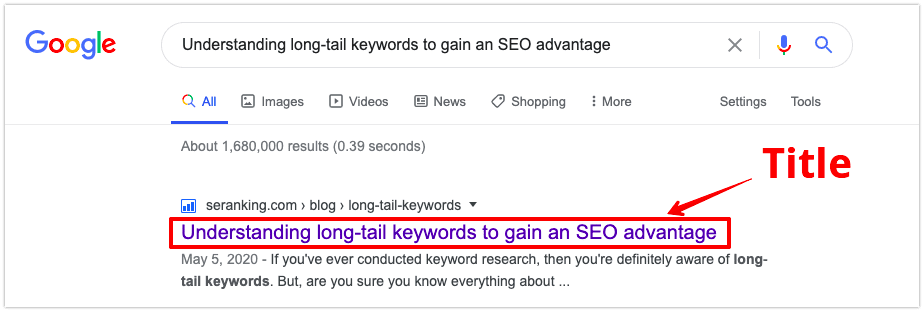In today's digital landscape, search engine optimization(SEO) has become an indispensable component of successful online marketing strategies. Its ability to optimize websites and contentfor search engines not only increases online visibility but also drives targeted traffic, leading to businessgrowth.
While SEOprovides numerous advantages for businesses of all sizes, enterprise-level organizations can particularly leverage the power of SEOto gain a competitive edge in the market.
Let's explore the top five value-added SEO benefits that enterprise SEO value addsto your organization.
Enhanced Brand Visibility And Credibility
Appearing at the top of search engineresults pages (SERPs) is crucial for building brand visibility and credibility. Users tend to trust and click on top-ranking results more frequently, perceiving them as reputable and authoritative sources.
Implementing a robust enterprise SEO strategyensures that your website ranks higher for relevant keywords, allowing your brand to gain maximum visibility among your target audience. Consistently appearing at the top of search results establishes your brand as a leader in your industry, thereby increasing trust and credibility among potential customers.
Increased Organic Traffic And Lead Generation
One of the primary goals of SEO is to drive organic traffic to your website. Organic traffic refers to visitors who find your website through unpaid search results. Compared to other traffic sources such as paid advertisements or social media, organic traffic is highly valuable as it reflects genuine user interest in your products or services.
A well-executed enterprise SEO strategy significantly increases organic traffic by optimizing website structure, content, and technical aspects. It helps search engines better understand your website, making it easier for them to index and rank your pages. As your website starts to rank higher for relevant keywords, you will experience a substantial increase in targeted organic traffic.
Moreover, organic traffic generated through SEO tends to have a higher conversion rate. When users find your website through search engines, they are actively looking for information, products, or services related to your industry. By offering valuable and relevant content that aligns with their search intent, you can turn these organic visitors into qualified leads, driving businessgrowth and revenue.
Key Statistics
- The top 3 Google search results get 75% of all clicks.
- The top spot on mobile gets 27.7% of all clicks (the second gets 9.2%).
- On average, moving up one spot increases CTR by 30.8%.
- 75% of users never make it past the first page of search results.
- Organic search contributes 51% of site traffic.
Competitive Advantage And Market Domination
Gaining a competitive advantage is paramount in the highly competitive landscape of enterprise-level businesses. By investing in enterprise SEO, you can position your organization ahead of competitors, dominating the market and capturing a larger share of the audience.
Effective SEO strategies involve in-depth keyword research, competitor analysis, and understanding the search landscape within your industry. By identifying keywords and topics with high search volumes and low competition, you can create optimized content that outperforms your competitors in search rankings.
To achieve effective meta titles at an enterprise scale, implementing a key strategy is essential. This strategy involves conducting comprehensive keyword research, analyzing competitors' SEO strategies, and developing high-quality, optimized content that aligns with user search intent.
Conduct Comprehensive Keyword Research
Keyword research is a fundamental step in optimizing meta titles. It involves identifying high-volume, low-competition keywords that are relevant to your target audience. By understanding the specific keywords and phrases users are searching for, you can create meta titles that align with their search intent and increase the visibility of your webpages in search results.
To conduct comprehensive keyword research, utilize a combination of tools and techniques:
- Keyword Research Tools- Utilize keyword research tools such as Google Keyword Planner, SEMrush, or Ahrefs to discover relevant keywords related to your industry or niche. These tools provide valuable insights into search volume, competition, and related keyword suggestions.
- Long-Tail Keywords- Focus on long-tail keywords, which are more specific and typically have lower competition. Long-tail keywords often reflect users' specific queries and are more likely to result in higher conversion rates.
- User Intent- Consider the user intent behind specific keywords. Are users looking for information, products, or services? Understanding user intent will help you create meta titles that align with their needs and increase the chances of attracting targeted traffic.
- Competitor Analysis- Analyze the meta titles used by your competitors and identify keywords they are targeting. Look for opportunities to differentiate your meta titles by targeting alternative keywords or finding gaps in their keyword strategies.
By conducting comprehensive keyword research, you can identify the most relevant and valuable keywords to incorporate into your meta titles, improving their SEO effectiveness.
Analyze Competitors' SEO Strategies
Analyzing your competitors' SEO strategies provides valuable insights into what is working in your industry and identifies areas for improvement. By understanding how competitors optimize their meta titles, you can develop strategies to differentiate your own titles and attract more clicks.
Here are some key steps to analyze competitors' SEO strategies:
- Identify Competitors- Identify the main competitors in your industry or niche. These are the websites and businesses that consistently rank well for the keywords you're targeting.
- Analyze Meta Titles- Review the meta titles used by your competitors. Pay attention to their length, language, use of keywords, and unique selling points. Identify patterns and common practices that you can leverage or improve upon.
- Identify Gaps and Opportunities- Look for gaps or missed opportunities in your competitors' meta titles. Are there specific keywords or unique selling points that they are not targeting? By addressing these gaps, you can differentiate your titles and attract users who are seeking those specific attributes.
- Learn from Successful Competitors- Identify competitors that consistently rank well and have high click-through rates. Analyze their meta titles and understand what makes them successful. Is it the use of trigger words, compelling language, or unique value propositions? Incorporate these insights into your own meta titles.
By analyzing your competitors' SEO strategies, you can gain valuable insights and inspiration to optimize your meta titles effectively.
Develop High-Quality, Optimized Content
Creating high-quality, optimized content is the foundation for successful meta titles. Your meta titles should accurately represent the content of your webpages and provide a compelling reason for users to click through to your site.
Here are some key considerations when developing optimized content:
- Keyword Placement- Incorporate your target keyword strategically within the meta title. Ideally, place it toward the beginning of the title to enhance visibility and relevance.
- Relevance and Clarity- Ensure that your meta title accurately reflects the content of the webpage. Users should be able to understand what the page is about by reading the meta title alone.
- Engaging Language- Use language that captivates and entices users to click. Incorporate trigger words, such as "exclusive," "limited time," or "free," to create a sense of urgency or highlight unique selling points.
- Length Optimization- Aim for meta titles that fall within the recommended length of 30 to 60 characters. This ensures that the title is displayed properly in search results and provides enough information to entice users.
- Avoid Keyword Stuffing- While incorporating keywords is important, avoid excessive keyword stuffing that may be penalized by search engines. Maintain a balance between optimization and natural language.
Remember, meta titles are just one aspect of developing high-quality, optimized content. Ensure that the content on your webpages is valuable, informative, and engaging to provide a positive user experience.
By implementing this key strategy, conducting comprehensive keyword research, analyzing competitors' SEO strategies, and developing high-quality, optimized content, you can optimize your meta titles effectively and improve your overall SEO performance.
Improved User Experience And Engagement
Providing a positive user experience (UX) is vital for website success. Search engines consider user signals, such as bounce rate, time on site, and click-through rates, as indicators of a website's quality and relevance. By improving your website's UX, you not only satisfy search engine algorithms but also provide a positive experience for your users.
Enterprise SEO focuses on optimizing various elements of your website to enhance user experience. This includes optimizing page load speed, ensuring mobile responsiveness, improving site navigation, and creating user-friendly interfaces. When users find your website easy to navigate and the content relevant to their needs, they are more likely to engage with your brand, explore additional pages, and convert into customers or subscribers.
Here are some key tips to optimize UX:
Optimize Page Load Speed
Page load speed plays a critical role in user experience. Slow-loading pages can lead to higher bounce rates and frustration among users. To optimize page load speed, consider the following.
- Compress Images- Large images can significantly slow down page load times. Optimize images by compressing them without compromising quality. Use image compression tools or plugins to reduce file sizes and ensure faster loading.
- Leverage Browser Caching- Enable browser caching to store static resources, such as images, CSS files, and JavaScript, on users' devices. This way, subsequent visits to your site will load faster, as the browser retrieves cached resources instead of fetching them from the server again.
Ensure Mobile Responsiveness
With the increasing use of mobile devices, it's crucial to provide a seamless user experience across different screen sizes. Ensure that your website is mobile responsive by.
- Responsive Design- Implement responsive design principles, allowing your website to adapt to various screen sizes and orientations. This ensures that users can easily navigate and interact with your site, regardless of the device they're using.
- Mobile-Friendly Testing- Regularly test your website's mobile-friendliness using tools like Google's Mobile-Friendly Test. This will identify any issues and provide suggestions for improvement.
Improve Site Navigation
Effective site navigation helps users find the information they're looking for quickly and easily. Consider the following tips to improve site navigation.
- Clear Menus- Create clear and well-organized menus that guide users to different sections of your website. Use descriptive labels and logical categorization to help users understand the content hierarchy.
- Intuitive Categories- Structure your website's content into intuitive categories that reflect users' expectations. This allows users to navigate your site with ease and find the relevant information they're seeking.
- Internal Linking- Utilize internal linking to connect related content within your website. This not only enhances navigation but also improves SEO by establishing connections between different pages.
Create User-Friendly Interfaces
User-friendly interfaces contribute to a positive user experience and encourage engagement. Consider the following tips when designing your website's interface.
- Clear Calls-to-Action- Use clear and compelling calls-to-action (CTAs) to guide users towards desired actions. Well-designed CTAs, such as "Buy Now," "Sign Up," or "Learn More," help users understand what to do next and encourage conversions.
- Intuitive Design- Design your website with a user-centric approach, focusing on simplicity and intuitive interactions. Use consistent visual elements, logical layouts, and easy-to-understand navigation to create a smooth and enjoyable user experience.
- Readable Typography- Choose typography that is easy to read across different devices and screen sizes. Optimize font sizes, line spacing, and contrast to ensure legibility.

9 Core UI/UX Design Principles for Better User Engagement
By implementing these UX optimization tips, you can create a user-friendly website that provides a seamless experience, engages your audience, and encourages conversions. Remember to continually evaluate and refine your UX strategies based on user feedback and evolving industry standards.
Long-Term Cost Efficiency And ROI
Compared to traditional marketing channels like TV advertisements or print media, enterprise SEO offers significant long-term cost efficiency. While implementing a comprehensive SEO strategy requires an initial investment of time, resources, and expertise, the ongoing costs are relatively lower.
Once you have established a solid SEO foundation, maintained a strong online presence, and achieved higher rankings, the organic traffic generated will continue to flow without additional costs. Unlike paid advertising campaigns that require continuous funding, SEO allows you to enjoy sustained visibility and traffic over an extended period.
Furthermore, the return on investment (ROI) from enterprise SEO can be substantial. As you gain higher visibility, increased organic traffic, and improved conversion rates, the revenue generated from SEO-driven leads and sales can surpass the initial investment. By consistently optimizing your website and adapting to evolving search trends, you can continuously improve your SEO performance and maximize your long-term ROI.
Key Benefits:
- Long-term cost efficiency compared to traditional marketing channels.
- Sustained visibility and traffic without additional costs.
- Substantial ROI through increased leads and revenue.
Incorporating Enterprise SEO Value Adds
Enterprise SEO value adds go beyond the individual benefits discussed above. It involves leveraging SEO as a strategic tool to drive growth, enhance business intelligence, support product marketing, and align departments for success.
Business Intelligence
Business intelligence (BI) plays a crucial role in enterprise SEO. By harnessing the power of data, BI provides valuable insights into customer behavior, purchasing patterns, and market trends. Enterprise SEO professionals can use this data to make informed decisions, align digital strategies with business goals, and pivot in real-time to meet consumer needs.
Brand Messaging And Reputation
SEO benefits your business by increasing brand awareness and creating potential customers. Even if searchers don't click through to your website, they still see your brand name and become more familiar with it. This increased brand awareness can lead to more traffic and conversions as people remember your brand when looking for products or services. Being on the first page of search results also improves your brand's reputation and credibility.
Digital User Experience
In the age of personalized experiences, SEO adds value to all parts of an organization. By understanding what online users are looking for and improving digital offerings, enterprises can create targeted and customized experiences for their customers. Collaboration across departments such as content, UX, design, and IT is crucial to optimize user experience and drive success.
Product Marketing
SEO helps product marketers understand customers' pain points, challenges, and aspirations. By analyzing search queriesand search result pages, product marketers can gain insights into customer needs and preferences. This data-driven approach enables marketers to develop messaging and content that resonates with their target market, ultimately driving product success.
WorkStream Support
Enterprise SEO professionals can also support various workstreams within the organization. From alerting sales and customer serviceabout market changes to providing data-driven insights for omnichannel campaigns, SEO professionals play a crucial role in aligning departments and fueling growth. By automating data reporting, providing valuable analytics, and facilitating offline campaign synergy, enterprise SEO adds value across multiple workstreams.

Enterprise SEO is Different: Here's Why
People Also Ask
What Is The Importance Of Enterprise SEO?
The importance of enterprise SEO lies in its ability to enhance the organic presence and revenue of larger organizations. By implementing effective SEO strategies tailored to the scale of enterprise websites, these organizations can maximize their online visibility and drive substantial revenue growth.
What Is The Business Value Of SEO?
The business value of SEO lies in its ability to generate organic traffic by attracting search engine users to your website. As search engines are the primary tool for online experiences, SEO plays a crucial role in driving website visibility and user engagement, making it an essential aspect of business success.
Who Benefits Most From SEO?
The primary beneficiaries of SEO are businesses seeking to promote their brand, increase awareness, drive quality traffic, improve user experience, convert leads into loyal customers, and maintain high organic search rankings. SEO ensures that businesses receive the visibility and promotion they deserve to thrive in the online landscape.
Conclusion
In conclusion, enterprise SEO offers numerous benefits for organizations. It enhances brand visibility, drives organic traffic and leads, provides a competitive edge, improves user experience, and ensures long-term cost efficiency and ROI. By incorporating enterprise SEO value adds such as business intelligence, brand messaging, digital user experience, product marketing, and workstream support, organizations can further amplify the impact of SEO.
Embracing SEO as a strategic tool and integrating it into marketing strategies is essential for unlocking growth opportunities, establishing a strong online presence, and outperforming competitors. Remember, SEO goes beyond search engine rankings—it's about delivering valuable experiences and achieving meaningful business outcomes.


